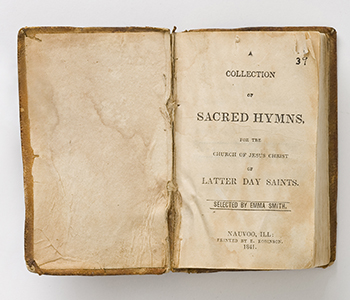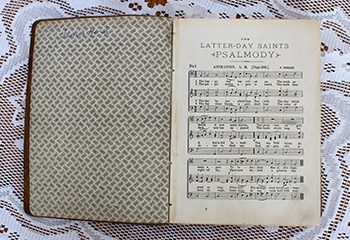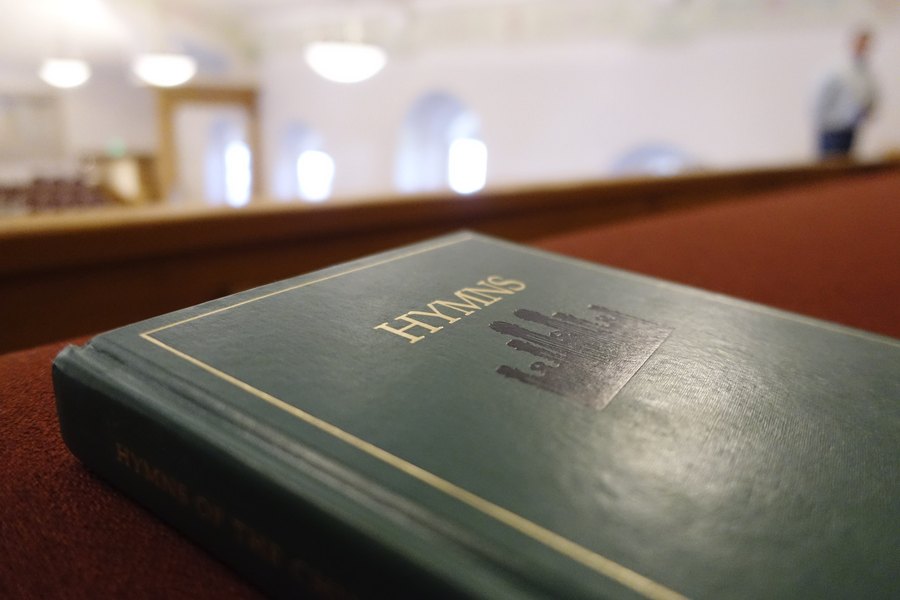Prior to the current edition of the LDS hymnbook, which was published in 1985, there were multiple versions used. With the ever-increasing membership in the Church worldwide, and to meet the varied needs of that membership, on Monday, 18 June 2018, The Church of Jesus Christ of Latter-day Saints announced plans to revise the current hymnbook. The project of creating a new Church hymnal which will “offer the same hymns and songs in all languages” will take several years to complete.

A Collection of Sacred Hymns for the Church of the Latter Day Saints was published in 1835. It was compiled by Emma Smith, who received a revelation from the Lord instructing her to “make a selection of sacred hymns.” Photo credit: www.lds.org.
Have you ever thought about how the LDS hymnbook came to be? In a revelation to the Prophet Joseph Smith in July 1830, just three short months after the Church was officially organized, the Lord directed his wife, Emma Hale Smith, to compile a hymnbook. We read in Doctrine and Covenants 25:11-12, “And it shall be given thee, also, to make a selection of sacred hymns, as it shall be given thee, which is pleasing unto me, to be had in my church. For my soul delighteth in the song of the heart; yea, the song of the righteous is a prayer unto me, and it shall be answered with a blessing upon their heads.”
At this time, the Prophet Joseph Smith’s life was often in danger, and the members endured persecutions from mobs who interrupted meetings and threatened to harm Church members. It was also during this time that the Prophet Joseph Smith received revelations to strengthen, encourage, and instruct the Saints. One of the ways in which he was able to do this was through music.
Music has played a part in the events of man’s everyday life since his earliest days. For example, in the Old Testament of the Bible in Exodus 15, we learn of the musical festivals after the children of Israel crossed the Red Sea. At times music has also accompanied men into battle and has been used to celebrate victories in war. Songs and dance were used to honor kings at their coronation. Throughout history, music has been used to sooth troubled minds, accompany prophesying, and to express personal sorrow. In the Psalms, David used music to describe personal emotions as well as praise to God.
In an article in the November 1990 Ensign, Ardeth G. Kapp made this statement about music:
Music has a very powerful and wonderful influence in establishing feelings and moods that can lift and elevate your thoughts and your actions. But because it is so powerful, it is clearly used by the adversary to stimulate your thoughts, feelings, and moods, to pollute and poison your mind and cause you to do things you would not otherwise consider doing.
In an address to Brigham Young University on 26 September 1967, Elder Boyd K. Packer stated, “music is one of the most forceful instruments for governing the mind and the spirit of man.”
The first Latter-day Saint hymnal was not published until August 1835, five years after the revelation was received by Joseph Smith for Emma Smith to compile a book of hymns. Nevertheless, Emma fulfilled her assignment from the Lord. The little edition measured approximately three inches by four-and-a-half inches and included 90 hymn texts, with 39 of those hymns written by Latter-day Saint poets, including Eliza R. Snow and Parley P. Pratt.
The 11 August 1985 edition of the Church News reports:
As Emma Smith began to gather a hymn collection for the new Church, two influences were significant for her. On the one hand, she had a lifetime of experience with the beloved folk hymns, revival songs, and traditional Protestant anthems of her New England religious background.
On the other hand, she felt the need for a hymn tradition that would reflect the unique history and theology of the Latter-day Saints. As heirs of divinely restored truth, the early saints wanted to do more than just borrow from other Christian hymn traditions.

Latter-day Psalmody was compiled in 1889 and was the first hymnbook to include both text and music for the hymns. Photo credit: www.lds.org
Since that time, hymns have continued to be a source of strength, comfort, and worship to Church members. President Spencer W. Kimball said, “It is obvious to remain clean and worthy, one must stay positively and conclusively away from the devil’s territory” (Miracle of Forgiveness, Salt Lake City: Bookcraft, 1969, page 232). As Christians, we represent Christ always – wherever we go, whatever we say. We should focus on what our Heavenly Father has done for us and express praises to Him out of gratitude. One way that we can do that is through the singing of hymns. The First Presidency Preface of the 1985 edition of the hymnal reads in part, “Some of the greatest sermons are preached by the singing of hymns. Hymns move us to repentance and good works, build testimony and faith, comfort the weary, console the mourning, and inspire us to endure to the end.”
Over the course of time, different collections of gospel hymns have been compiled. In 1889, the first hymnbook to include both the text of the hymn and music, the Latter-day Psalmody was published. By 1908, another compilation had been published, called Songs of Zion, and included 100 gospel hymns. A century and a half after Emma Smith compiled the first LDS hymnal, in 1985, the Church published the current hymnbook, Hymns, which is comprised of 341 hymns and is available in nearly 40 languages.
The First Presidency Preface of the 1985 edition of the hymnal further states, “We hope to see an increase of hymn singing in our congregations. We encourage all members, whether musically inclined or not, to join with us in singing the hymns. We hope leaders, teachers, and members who are called upon to speak will turn often to the hymnbook to find sermons presented powerfully and beautifully in verse.”
Below is a video which tells the story behind hymn no. 60, “Battle Hymn of the Republic.”



